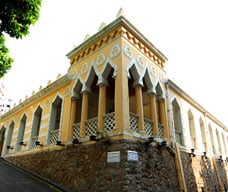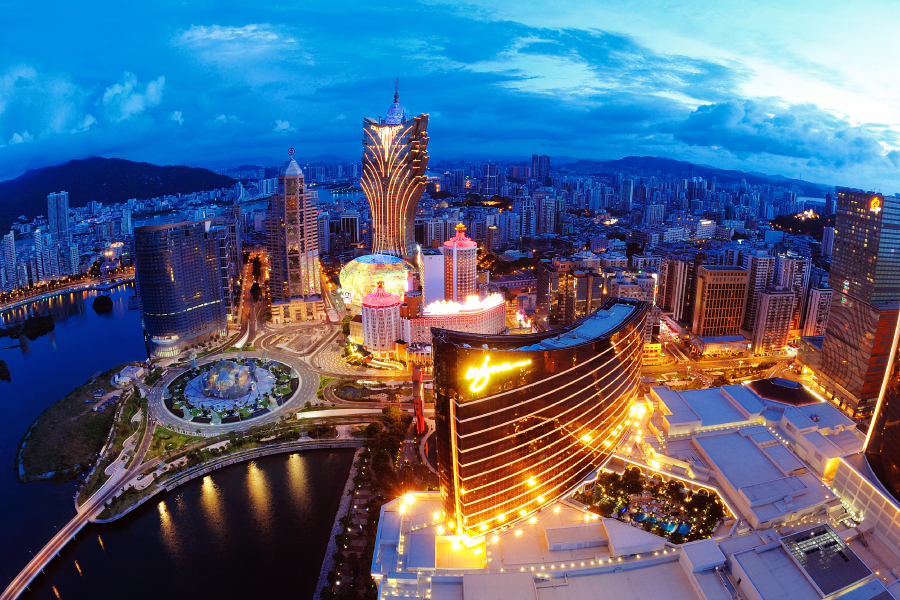By Roger Allnutt, Travel Writer
MACAU, CHINA — In the past decade or so the former Portuguese enclave on the south coast of China near Hong Kong has undergone a dramatic transformation.
On the one hand the slower paced and historic elements of the territory (it reverted to China in 1999) together with a definite European and Chinese feel has been matched by the rapidly expanding luxury hotel complex of the Cotai Strip on Taipa island which attracts huge numbers of mainland Chinese to the casinos and gambling tables.
Founded in 1557 during the great era of Portuguese exploration it enjoyed boom economic times, served as a base for the introduction of Christianity to China and Japan and as a summer residence for the great traders (‘taipans’) of Canton.

The city of Macau is built on a peninsula connected to mainland China and by bridge and causeway to the islands of Taipa and Coloane. The old stone Barrier Gate that for many years tourists passed through to visit China has been preserved while adjacent to it hundreds of local workers pass through daily in both directions. The total area of the territory is about 29 sq km but the rapid land reclamation program is likely to markedly increase its size in the coming years.
The best way to ‘see’ Macau is a combination of coach tour and walking. The city area contains numerous narrow streets and alleyways linking a number of historic sights. In recognition of its unique Portuguese and Chinese heritage the city was declared a World Heritage Site in 2005, listing over 30 historic sites. Some of the narrow streets are used for the Macau Grand Prix held each November.

The most famous sight in Macau is the ruins of St Paul’s Church (after a fire in 1835 only the facade remains) at the top of 68 steps rising from the alleyways near Senado Square; paved in a wave-patterned mosaic the square is the focal point of the centre of the city. The ruins are adjacent to the Mount Fortress that now contains the excellent Museum of Macau, full of fascinating exhibits.
Many more interesting sights can be found in the vicinity of Senado Square, churches like the Cathedral, St Dominic’s and Kuan Tai Temple. The best shopping is in the area ranging from upmarket boutiques to small shops selling everything from antiques to cameras, perfumes to flowers. Small shops sell local specialties including a sort of beef jerky and lots of cakes and sweets. Street vendors try to capture your eye for a business deal. Cafes and restaurants are always busy especially at lunchtime. Don’t miss trying the lovely egg tarts fresh and hot from the baker’s oven.

At handover in 1999 the different provinces and major cities of China presented Macau with gifts usually reflecting a key element of their region and these amazing gifts are now housed in the appropriately named Handover Gifts Museum located close to where the actual ‘handover’ took place. Visiting the museum is not to be missed.
Macau is surprisingly hilly and you get excellent views over the harbour, the Pearl River and across to mainland China from a number of vantage points. The old lighthouse and chapel (elaborate frescoes on the walls) at Guia Fortress provide the best view and are symbols of Macau’s maritime, military and missionary past.

A stunning panoramic view can be obtained from the viewing platform of the relatively new 338m high Macau Tower. For those with strong stomachs and no fear you can either walk round the outside of the tower at the 233m level or for the biggest adrenalin rush jump from the same height in a ‘controlled descent’. I passed on both these options.
The name Macau is derived from that of a Chinese goddess known as A-Ma. The word A-Ma-Gao meaning Bay of A-Ma became shortened to Macau. On the waterfront facing the inner harbour is the Temple of A-Ma that was extensively rebuilt after a devastating fire in 1988 that miraculously left the statue of A-Ma blackened but otherwise unscathed. Adjacent to the temple the Maritime Museum has many interesting exhibits of Portuguese and Chinese maritime links.
For a different perspective on Macau head out to the islands of Taipa and Coloane. Taipa Village captures the essence of Macau, with neo-classical Portuguese government buildings sharing the narrow streets with pastel-coloured Chinese Coast houses and small red and gold temples. The biggest attraction is the “food street” containing dozens of restaurants and cafés; try the superb Macanese food where the mixture of Chinese and Portuguese influences is reflected in the magnificent cuisine featuring giant king prawns, shrimp, crab and many other fish cooked using interesting spices, curries and coconut. Unlike Hong Kong where wine is fearfully expensive, in Macau you can try excellent Portuguese wines at reasonable prices. I would recommend trying local places such as the superb O Manuel or Cafe Litoral on Taipa.
For over two hundred years Macau has had casinos – it is the only place with legal casinos in China. Most of the casinos are located in the Cotai Strip on Taipa and their number is growing all the time as new ones come on line. Some of the casinos are associated with hotels; casinos operate for 24 hours a day. It is sobering to see the amounts of money wagered on the tables; Chinese are renowned gamblers and Macau is a mecca for them.
The most impressive is undoubtedly the amazing The Venetian which truly is over the top. The outside of the complex is surrounded by lakes on which you can have gondola rides; inside is the hotel and casino and hundreds of upmarket shops. The many Chinese visitors to Macau are inexorably drawn to the shops as well as the casino gambling areas – at some shops like Chanel and Gucci (these are also found at other hotels) queues form early to get in when they open. The centrepiece is the recreation of the canals of Venice complete with bridges, open plazas and on the gondolas I heard Italian opera being sung by Chinese gondoliers. The roof of the ceiling of the area is incredibly painted like natural sky. Other impressive hotels and casinos at Cotai include Conrad, Sheraton, Four Seasons and Crown Tower. More central in Macau city area are Wynn, Landmark and MGM while Westin Resort is on Coloane and Hyatt Regency is on Taipa. For something very traditional try the boutique Pousada de Santiago.
For most visitors from the United States Macau is an added stopover from Hong Kong. Ferries are the usual method of getting to Macau from Hong Kong but this may change when a new 29km long road bridge across the open water between Hong Kong and Macau opens in 2016, a staggering engineering feat. (Macau – located on the western bank of the Pearl River Delta in southern Guangdong Province, China – adjoins the Mainland city of Zhuhai and lies some 60 kilometres to the west of Hong Kong.)
—–
Macau – located on the western bank of the Pearl River Delta in southern Guangdong Province, China – adjoins the Mainland city of Zhuhai and lies some 60 kilometres to the west of Hong Kong. Macau comprises Macau Peninsula, Taipa and Coloane islands. Macau Peninsula is the hub of the territory and is connected to Taipa Island by three road bridges. Several large international hotel resorts – with new supporting infrastructure – are located on the reclaimed land between Taipa and Coloane in the newly developed district known as Cotai.
The Portuguese arrived and settled in Macau in the mid 16th Century. Thus, the city’s architecture, art, religion, traditions, food and community reflect the integration of Chinese, Western and Portuguese cultures. Macau became a Special Administrative Region of the People’s Republic of China on 20th December 1999 and exercises a high degree of autonomy under the principle of “One country, two systems”. The tiny SAR is growing in size with more buildings on reclaimed land, and in the number and diversity of its attractions. In 2005, The Historic Centre of Macau was inscribed on the UNESCO World Heritage List as a result of its unique historical and cultural landscape. Macau is currently positioning itself as the World Centre of Tourism and Leisure as it develops into a quality international tourist destination.

